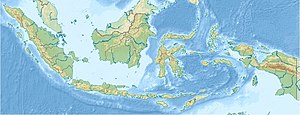Northern Loloda Islands
| Northern Loloda Islands | ||
|---|---|---|
| The Moluccas | ||
| Waters | Moluccan Sea | |
| Geographical location | 2 ° 11 ' N , 127 ° 46' E | |
|
|
||
| Number of islands | 4 main islands | |
The Northern Loloda Islands ( Indonesian Kepulauan Loloda Utara ) are an Indonesian group of islands in the Moluccas . The archipelago form the district ( Indonesian Kecamatan ) Loloda Kepulauan ( German Loloda Islands ) of the administrative district ( Indonesian Kabupaten ) North Halmahera ( Indonesian Halmahera Utara ) in the province of Northern Moluccas ( Indonesian Maluku Utara ).
geography
The Northern Loloda Islands lie northwest off the coast of Halmahera Island .
The largest island in the archipelago is Doi in the north of the archipelago. To the south of it are Tuakara (Tua Kara), the smallest of the main islands, Dagasuli and finally Salangadeke (also Tobo Tobo ). There are also a number of small islets, such as Sedeng and Deherete off the north coast of Doi and others.
Residents
The main town on Doi is Salube on the south coast. 1451 inhabitants live here (2010 census). The entire east coast of the island belongs to the place. 1,325 people live in Dama in the southwest. The west and north of the island belong to the village of Dowonggila , which has 303 inhabitants. 350 people live in Cera in the northwest .
On Dagasuli are the villages of Dagasuli (center) with 566, Dedeta (middle east) with 609, Fitako (east) with 360, and Jikolamo (west) with 186 inhabitants. 688 people live in the village of the same name on Salangadeke . Tuakara has 126 residents.
fauna
65 different bird species are known from the Northern Loloda Islands.
Endemic to the region are the Wallace large footed fowl (Eulipoa wallacei) , the large footed fowl (Megapodius freycinet) , the island fruit pigeon ( Ducula rosacea) , the blue-capped fruit pigeon (Ptilinopus monacha) , the Halmaherahabicht (Accipiter henicogrammus) , the red-necked pigeon , the Lasurliest (Todiramphus diops) and the Moluccan star (Aplonis mysolensis) .
The Wallace large footed partridge , the Matsudaira wave runner (Hydrobates matsudairae) and the great knot (Calidris tenuirostris) are classified as endangered . Are potentially vulnerable by IUCN island Fruchttaube, Blue Cap Fruchttaube, white face Shearwater (Calonectris leucomelas) , Orient Darter (Anhinga melanogaster) , Poole Schnepfe (Limosa lapponica) , Uferschnepfe (Limosa limosa) , Rotkehl-beach rotor (Calidris ruficollis) , Graytail-Wasserläufer (Tringa brevipes) , Halmaherahabicht and Rotnneckensperber.
tourism
Off the beaten track, there are some dive sites around the islands with coral reefs and underwater caves.
Web links
Individual evidence
- ↑ a b Mapcarta: Kepulauan Loloda Utara. accessed on November 12, 2016.
- ↑ The great world atlas. Millennium House, 2009, ISBN 978-1-921209-31-4 .
- ↑ a b Penduduk Indonesia menurut desa 2010 ( Memento from March 27, 2014 in the Internet Archive ) (Indonesian; PDF; 6.0 MB), accessed on January 26, 2013.
- ↑ a b c Avibase: Bird Control List North Loloda archipelago , accessed November 12, 2016.
- ↑ Halmahera Utara: Menyelam di Halmahera Utara. accessed on November 12, 2016.

